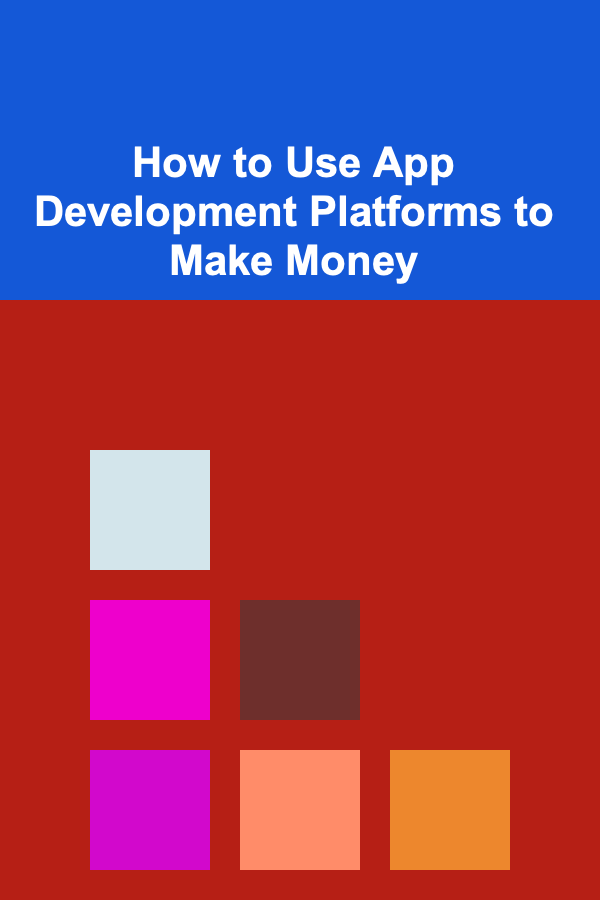
How to Use App Development Platforms to Make Money
ebook include PDF & Audio bundle (Micro Guide)
$12.99$5.99
Limited Time Offer! Order within the next:

In today's digital economy, mobile applications have become a cornerstone of business and entertainment. Whether it's a game, a utility app, or a social networking platform, mobile apps are everywhere, with billions of downloads every year. For developers, this represents a huge opportunity to monetize their skills and ideas. One of the best ways to enter the app development market is by leveraging app development platforms. These platforms make it easier for developers to create, test, and launch apps without needing extensive coding knowledge or large development teams. But the question remains: How can app developers use these platforms to make money? This article will explore how developers can effectively use app development platforms to build profitable mobile applications.
The Rise of Mobile App Development Platforms
Before diving into the ways to monetize apps, it's important to understand the role of app development platforms. These platforms have revolutionized the way developers approach mobile app creation. Traditionally, building an app required advanced knowledge of programming languages, SDKs (Software Development Kits), and APIs (Application Programming Interfaces). However, with the introduction of app development platforms, developers can now build high-quality apps using drag-and-drop features, pre-built templates, and visual design tools.
Some well-known app development platforms include:
- Appy Pie
- Flutter
- Xamarin
- React Native
- BuildFire
- Swiftic
These platforms provide different functionalities and capabilities, catering to a wide range of developers. Whether you are a beginner or a seasoned developer, these platforms allow you to design, test, and publish apps without having to write complex code.
With the accessibility of these platforms, the app development process has become more streamlined, allowing developers to focus on creating innovative solutions rather than worrying about the technical intricacies. However, the key question is how to leverage these platforms to generate revenue. Let's explore how developers can turn their app ideas into profitable ventures using various monetization strategies.
Ad Revenue: Earning through In-App Advertisements
One of the most popular ways to monetize apps is through in-app advertisements. Ads can be integrated into the app in various ways, such as banners, interstitials, native ads, and rewarded video ads. This method works particularly well for free-to-use apps, where users don't pay to download or use the app. Instead, the app generates revenue from ad impressions or clicks.
Types of Ads for Monetization:
- Banner Ads: These are small advertisements displayed at the top or bottom of the app screen. They are less intrusive and provide a consistent stream of revenue.
- Interstitial Ads: These are full-screen ads that appear at natural transition points in the app, such as between levels in a game or after a user completes a task.
- Rewarded Video Ads: Users are shown a video ad in exchange for a reward, such as in-game currency or bonus features. This is particularly effective in gaming apps.
- Native Ads: These ads match the look and feel of the app's content, making them less intrusive and more engaging for users.
Ad networks like Google AdMob , Facebook Audience Network , and Unity Ads offer easy-to-integrate solutions for developers. By embedding these networks into your app, you can start earning from each ad viewed or clicked by your app users. While ad revenue can be a reliable source of passive income, the amount you earn depends on factors such as user engagement, ad placement, and the number of active users.
In-App Purchases (IAPs): Selling Virtual Goods
Another common and highly profitable method of monetizing mobile apps is through in-app purchases (IAPs). IAPs allow developers to sell virtual goods, premium content, or additional features within the app itself. This is particularly popular in mobile games and utility apps, where users can unlock new levels, characters, or tools through purchases.
Common In-App Purchases:
- Cosmetic Items: These include skins, avatars, themes, and customization options. For example, users may pay for a special skin for their character in a game.
- Premium Content: This could involve unlocking exclusive content such as special levels, tutorials, or music tracks.
- Subscriptions : Some apps offer users a subscription model, where they pay a recurring fee for access to premium content or features. For example, fitness apps like MyFitnessPal or music apps like Spotify use subscriptions as their primary revenue model.
- Power-ups or Boosters: In mobile games, players often purchase in-game currency or boosters to enhance their gameplay experience.
App development platforms, like Flutter and React Native , provide easy integration for IAPs, making it simple for developers to implement. Furthermore, app stores like Google Play and Apple's App Store offer tools to manage in-app purchases efficiently.
While offering in-app purchases can be lucrative, it's important to strike the right balance between paid and free content to ensure that users don't feel forced to make purchases to enjoy the app. Too many paywalls can lead to frustration and low retention rates.
Subscription Models: Earning Recurring Revenue
A subscription-based model has proven to be one of the most effective ways to create consistent and predictable revenue streams for mobile apps. With a subscription model, users pay a recurring fee (monthly, yearly, etc.) to access premium content or features. This model works particularly well for apps that provide ongoing value, such as news, entertainment, fitness, and productivity apps.
Key Features of Subscription Apps:
- Freemium Model : The app is free to download and use, but premium features are locked behind a paywall. Examples include apps like Evernote or Headspace, where basic features are free, but users must pay for advanced capabilities.
- Free Trial : Many apps offer a free trial period, allowing users to experience premium content before deciding whether to subscribe. This is a popular tactic in streaming services like Netflix and Apple Music.
- Tiered Subscriptions: Some apps offer multiple subscription tiers, giving users the option to pay for varying levels of access. For instance, an app might offer a basic plan for casual users and a premium plan for more dedicated users.
Platforms like Appy Pie and Xamarin make it easy to integrate subscription models into your app. The key to success with subscriptions is providing ongoing value that encourages users to stick with the app over the long term.
Affiliate Marketing: Earning Commissions through Referrals
Affiliate marketing is another effective monetization strategy for mobile apps. This method involves promoting third-party products or services within your app and earning a commission for each sale or action generated through your referral link. Apps that provide recommendations, product reviews, or curated content are ideal candidates for affiliate marketing.
How Affiliate Marketing Works in Apps:
- Product Recommendations: If your app helps users make decisions, such as a shopping app or review platform, you can include affiliate links to products.
- Discount Coupons and Deals: Apps can partner with brands to offer users exclusive discount codes or deals, earning a commission for each purchase made using the code.
- Travel and Hotel Booking Apps : If your app offers travel recommendations, integrating affiliate links from services like Booking.com or Airbnb can be a profitable way to earn commissions on bookings made through your app.
Affiliate marketing can be a powerful tool for monetization, especially when paired with engaging content and high-quality recommendations. Developers can use platforms like Amazon Associates or ShareASale to find affiliate programs that align with their app's content.
Selling Data: Leveraging User Data for Profit
User data is a valuable asset that can be used for a variety of purposes, including marketing and research. Many app developers can monetize their apps by selling anonymized data to third parties. This data may include user behavior, preferences, and demographics.
However, developers need to ensure that they comply with privacy regulations such as the General Data Protection Regulation (GDPR) in Europe and California Consumer Privacy Act (CCPA). Transparency and user consent are critical in this area.
How to Monetize User Data:
- Analytics Services: Some apps collect data to improve user experience, and the aggregated data can be sold to marketers, research firms, or other businesses.
- Targeted Ads: By gathering user data, developers can provide more accurate and targeted advertising, which can increase ad revenue.
- Market Research: App developers can provide valuable market insights to companies looking to understand consumer behavior and trends.
While data monetization can be profitable, it's crucial to respect user privacy and be transparent about how their data will be used.
Crowdfunding: Raising Capital for Your App
For developers looking to fund the development of a new app, crowdfunding can be an excellent way to raise capital. Platforms like Kickstarter and Indiegogo allow developers to pitch their ideas to a global audience, with backers pledging money in exchange for early access, rewards, or equity in the app.
Crowdfunding is not a direct monetization strategy, but it can help developers gather the resources needed to bring their app to life. By building a community around your app and offering valuable incentives, crowdfunding can be an effective way to secure funding without relying on traditional investors.
Conclusion: Choosing the Right Monetization Strategy
As the app market continues to grow, developers have more opportunities than ever to monetize their mobile applications. Whether through ad revenue, in-app purchases, subscriptions, affiliate marketing, or crowdfunding, app development platforms provide the tools necessary to build successful apps that can generate consistent revenue.
The key to success lies in choosing the right monetization strategy based on the app's niche, target audience, and features. Developers should also be mindful of user experience, ensuring that their chosen monetization method aligns with the overall app experience and doesn't hinder user engagement.
By leveraging the capabilities of app development platforms, developers can not only create functional and innovative apps but also turn them into profitable ventures in the ever-expanding mobile app market.
Other Products

How to Cut Costs on Groceries Without Compromising Nutrition
Read More
How to Find Part-Time Writing Jobs on Freelance Platforms
Read More
How to Host a Memorable Dinner Party at Home
Read More
How to Maintain Your Home's Roof Flashing
Read More
How to Prepare for Tax Season Throughout the Year
Read More